-
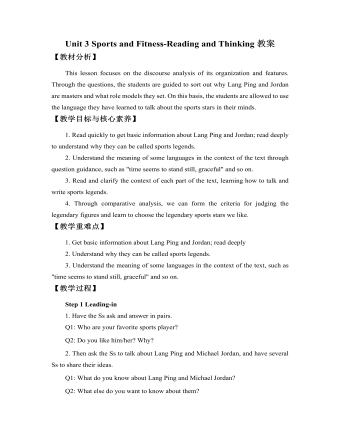
新人教版高中英语必修1Unit 3 Sports and Fitness-Reading and Thinking教案
2. Sort out detailed information about Michael Jordan.(1) Understand the transitional sentence.Q: Which part is about Michael Jordan as a master? Which part is about the example he set?(2) Have the Ss Focus on why Michael Jordan is a master and what good examples Michael Jordan set when they’re reading. And think about these questions as below:Q1: How does the author describe his impressive skills?Q2: How do you understand “time seemed to stand still”?Q3: What does “graceful” mean?Q4. Which sentence do you think best describes his mental strength?Q5. Which words is important in the sentence in describing his mental strength? Why?Q6: How do you understand “unique”?Q7: What can we learn from Michael Jordan?Step 5 Discussing and recommendingRecommend their own living legends of sports.Work in groups to choose your own living legend of sports and give the reasons of your choice. Step 6 HomeworkReview the stories of Lang Ping and Michael Jordan, and try to retell them.

新人教版高中英语必修1Unit 3 Sports and Fitness-Reading for Writing教案
Then have them write a short paragraph to describe and explain their changes. After that, get the Ss to exchange their drafts with their partners and use the checklist to give feedback on their drafts, and finally revise it.Step 5 Summary of how to write a wellness book1.健康书的审题步骤:第一步:明确要求该写作属于经验分享,故要用第一人称来写;时态以一股现在时为主。第二步:确定段落该类文章可以从以下三个方面人手:Para.1首先表明写作的目的Para.2自己的做法及心得体会Para.3表示期望及感谢第三步:提炼要点2.健康书常见句式:1) It is an honor for me to share my favorite sport with you,2) It makes me feel relaxed playing with my friends.3) It makes me rid myself of stress while playing with my friends.4) Moreover, it provides me a valuable chance to communicate with others.5) I we eat too little or too much, or if we choose the wrong food, we may become sick.6) We can do something to change the poor situation.Step 6Homework假如你的老师让你在班级Wellness Bok上分享自己的亲身经历及心得,请根据以下要点写一篇80字左右的文章1. 你喜欢的运动是什么?2. 你最喜欢的原因是什么?3. 你参加锻炼的体会。
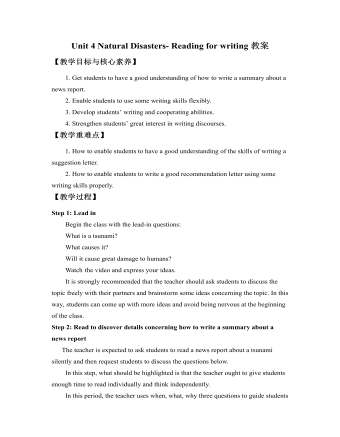
新人教版高中英语必修1Unit 4 Natural Disasters- Reading for writing教案
①标题——标题应当简洁明了。②导语——导语是消息开头的第一段或第一句话,简明扼要地揭示出消息的核心内容。③主体——主体是消息的主要部分,要用充足的事实表现主题,对导语的内容作进一步的展开和阐述。④结束语——通常是对全文内容进行概括性的总结。3. 新闻报道增分句子(1)陈述事实常用的句型:①A terrible storm hit/struck ... , killing ..②It was a cool autumn night when the earthquake happened. A large number of buildings fell down and roads were destroyed, leaving a great many people homeless.地震发生在一个凉爽的秋夜。大量的建筑物倒塌,道路被毁,许多人无家可归。③With the help of the rescue team, people who were the trapped in the flood were saved.在救援队的帮助下,困在洪水中的人们得救了。(2)陈述观点常用的句型:①Clearly/Obviously/In my opinion/It seemed that people were shocked.显然/在我看来/似乎人们震惊了。②The whole city was in ruins after the earthquake.地震后整个城市成了一片废墟。(3)揭示原因常用的句型:Because of/As a result of/Thanks to the help of the army, people who got injured were sent to the hospital immediately.
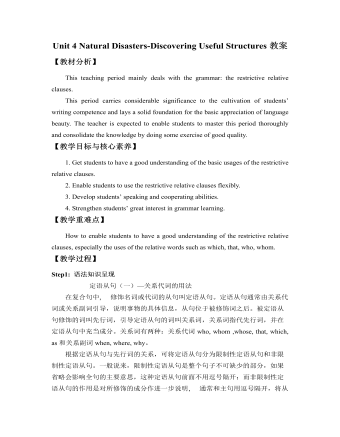
新人教版高中英语必修1Unit 4 Natural Disasters-Discovering Useful Structures教案
【教材分析】This teaching period mainly deals with the grammar: the restrictive relative clauses.This period carries considerable significance to the cultivation of students’ writing competence and lays a solid foundation for the basic appreciation of language beauty. The teacher is expected to enable students to master this period thoroughly and consolidate the knowledge by doing some exercise of good quality.【教学目标与核心素养】1. Get students to have a good understanding of the basic usages of the restrictive relative clauses.2. Enable students to use the restrictive relative clauses flexibly.3. Develop students’ speaking and cooperating abilities.4. Strengthen students’ great interest in grammar learning.【教学重难点】How to enable students to have a good understanding of the restrictive relative clauses, especially the uses of the relative words such as which, that, who, whom.【教学过程】Step1: 语法知识呈现定语从句(一)—关系代词的用法在复合句中, 修饰名词或代词的从句叫定语从句。定语从句通常由关系代词或关系副词引导,说明事物的具体信息,从句位于被修饰词之后。被定语从句修饰的词叫先行词,引导定语从句的词叫关系词,关系词指代先行词,并在定语从句中充当成分。关系词有两种:关系代词who, whom ,whose, that, which, as和关系副词when, where, why。
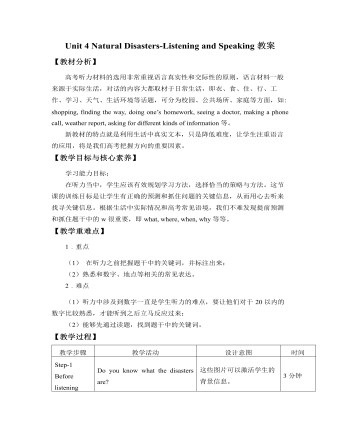
新人教版高中英语必修1Unit 4 Natural Disasters-Listening and Speaking教案
【教材分析】高考听力材料的选用非常重视语言真实性和交际性的原则,语言材料一般来源于实际生活,对话的内容大都取材于日常生活,即衣、食、住、行、工作、学习、天气、生活环境等话题,可分为校园、公共场所、家庭等方面,如: shopping, finding the way, doing one’s homework, seeing a doctor, making a phone call, weather report, asking for different kinds of information等。新教材的特点就是利用生活中真实文本,只是降低难度,让学生注重语言的应用,将是我们高考把握方向的重要因素。【教学目标与核心素养】学习能力目标:在听力当中,学生应该有效规划学习方法,选择恰当的策略与方法。这节课的训练目标是让学生有正确的预测和抓住问题的关键信息,从而用心去听来找寻关键信息。根据生活中实际情况和高考常见语境,我们不难发现提前预测和抓住题干中的w很重要,即what, where, when, why等等。
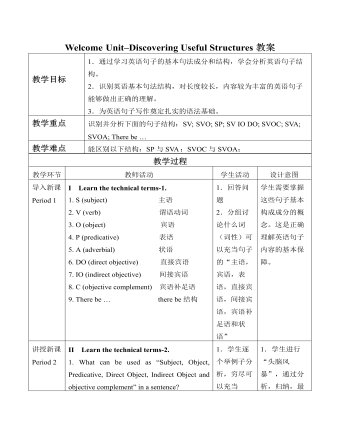
新人教版高中英语必修1Welcome Unit-Discovering Useful Structures教案
II Learn the technical terms-2.1. What can be used as “Subject, Object, Predicative, Direct Object, Indirect Object and objective complement” in a sentence?2. What can be used as “adverbial” in a sentence?3. What can be used as “verb” in a sentence?Answers to questions 1-3:1. Nouns, pronouns and appellations can be used as “Subject, Object, Predicative, Direct Object, Indirect Object and Objective Complement”. Besides, adjectives can be used as “Predicative and Objective Complement” in a sentence.2. Adverbs and prepositional phrases can be used as “Adverbial”.3. Verbs with actual meaning can be used as “Verb” in a sentence. Auxiliary verbs alone cannot be used as “Verb” in a sentence.III Learn to recognize the sentence structures.1. SV structure. For Example:(1) A bird flies.S V(2) A monkey jumps.S V(3) A fish swims.S V√ In SV structures, verbs are “intransitive verbs”.2. SVO structure. For Example:(1) A sheep eats grass.S V O(2) They like bananas.S V O(3) He wants candy.S V O√ In SVO structures, verbs are “transitive verbs”.3. SP structure. For Example:(1) This is great.S P (2) He looks well.S P (3) She became a teacher.S P √ In SP structures, Predicatives are formed by “link verbs” and “adjectives or nouns”.√ link verbs: be, become, grow, look, feel, taste, etc.4. SV IO DO structure. For Example:(1) He asked me a question.S V IO DO(2) Danny wrote me a letter.S V IO DO(3) Billy brought Sam a kite.S V IO DO√ In SV IO DO structures, the verbs are transitive and are followed by two objectives – pronouns or nouns as Indirect Objective, and nouns as Direct Objectives.
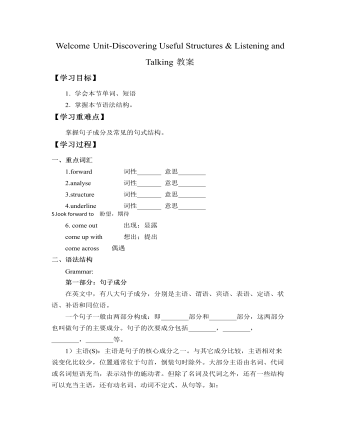
新人教版高中英语必修1Welcome Unit-Discovering Useful Structures & Listening and Talking教案
常跟双宾语的动词有:(需借助to的)bring, ask, hand, offer, give, lend, send, show, teach, tell, write, pass, pay, promise, return等;基本句型 五S +V + O + OC(主+谓+宾+宾补)特点:动词虽然是及物动词,但是只跟一个宾语还不能表达完整的意思,必须加上一个补充成分来补足宾语,才能使意思完整。 判断原则:能表达成—宾语 是…/做…注:此结构由“主语+及物的谓语动词+宾语+宾语补足语”构成。宾语与宾语补足语之间有逻辑上的主谓关系或主表关系,若无宾语补足语,则句意不够完整。可以用做宾补的有:名词,形容词,副词,介词短语,动词不定式,分词等。如:He considers himself an expert on the subject.他认为自己是这门学科的专家。We must keep our classroom clean.我们必须保持教室清洁。I had my bike stolen.我的自行车被偷了。We invited him to come to our school.我们邀请他来我们学校。I beg you to keep secret what we talked here.我求你对这里所谈的话保密。用it做形式宾语,而将真正的宾语放到宾语补足语的后面,以使句子结构平衡,是英语常用的句型结构方式。即:主语+谓语+it+宾补+真正宾语。如:We think it a good idea to go climb the mountain this Sunday.

新人教版高中英语必修1Unit 5 Languages Around the World-Reading and Thinking教案
【教材分析】本节课是高中英语第一册的最后一个单元的阅读和思考部分,文章难度明显增加,体现在以下几个方面:文章题材是说明文,比较难理解;话题生疏,涉及到历史等知识;生词量增大,而且在语境中理解词汇的要求提高。面对这些,教师的难度和高度也要有所提升,通过探讨说明顺序,了解背景知识等帮助他们找到说明文阅读的方法。【教学目标与核心素养】1. 文化意识目标新课程中指出,文化意识是对中外文化的理解和对优秀文化的认同。文化意识的的培养有助于学生增加国家认同和家国情怀,成为有文明素养和社会责任感的人。我们这个单元很好体现了这一点,通过了解汉字书写的体系和发展,学生可以有一种文化自豪感,同时也能够帮助学生深入挖掘这篇文章,从而想到更多和中国文化相关的方面。2. 学习能力目标
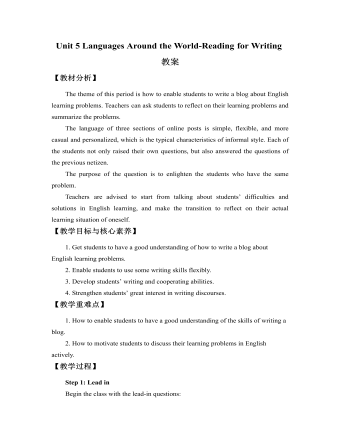
新人教版高中英语必修1Unit 5 Languages Around the World-Reading for Writing教案
Step 3: Read to sum upRead it again and sum up the problems of the three students, and then write down the advice that was given from others.Step 4: Work in pairs. List your learning problems in English and brainstorm some useful advice.Useful expressions ? I don't know how to…... Is a big difficulty for me. I cannot ...? You might try …. It's very important to…? I have no idea how/what .My biggest problem is .... ? I (also) have trouble with. My advice is …. This worked for me.? l cannot understand the teachers’ English in class.Step 5 Homework:为提高我校学生的英语口语水平,我们将举办英语演讲比赛(English- speaking contest),请你根据下面的信息,以学生会(the Students‘ Union)的名义写一份海报,欢迎全校同学参加,届时特邀本校美籍教师史密斯先生颁奖。? 报名时间 9月30日以前(报名:signup)? 报名地点 学生会办公室? 比赛时间 10月9日晚7:00~9:00? 比赛地点 学校大会议室? 奖励 前8名
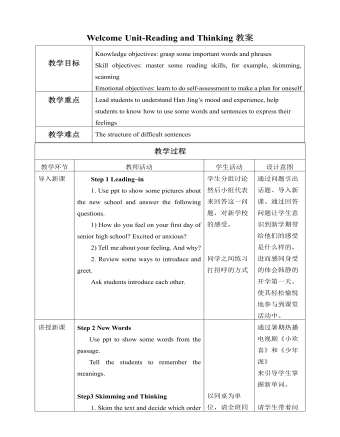
新人教版高中英语必修1Welcome Unit-Reading and Thinking教案
Step 2 New WordsUse ppt to show some words from the passage.Tell the students to remember the meanings.Step3 Skimming and Thinking1. Skim the text and decide which order Han Jing follows to talk about her first day. Time order or place order?Time order2. What is Han Jing worried about before she goes to senior high school?She is worried about whether she will make new friends and if no one talks to her, what she should do.Step 4 Fast Reading1. Match the main ideas with each paragraphParagraph 1:The worries about the new school day Paragraph 2Han Jing’s first maths classParagraph 3Han Jing’s first chemistry classParagraph 4Han Jing’s feelings about her first senior school dayStep 5 Careful Reading1. Fill in the chart with the words and phrases about Han Jing’s day. Answers: Senior high school, a little nervous; Her first maths class, classmates and teachers, friendly and helpful; Chemistry lab; new; great; annoying guy; Confident; a lot to explore2. Read the text again and discuss the questions.1) Why did Han Jing feel anxious before school?Because she was a new senior high student and she was not outgoing. What was more, she was worried about whether she can make friends.2) How was her first maths class?It was difficult but the teacher was kind and friendly. 3) What happened in the chemistry class? What would you do if this happened to you? A guy next to Han Jing tried to talk with her and she couldn’t concentrate on the experiment.
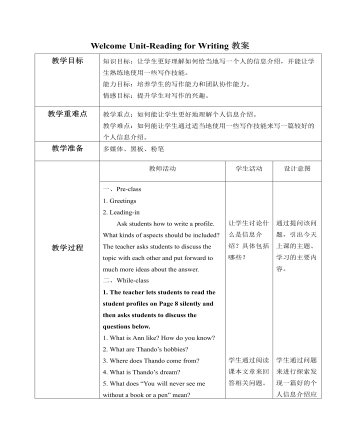
新人教版高中英语必修1Welcome Unit-Reading for Writing教案
教学目标知识目标:让学生更好理解如何恰当地写一个人的信息介绍,并能让学生熟练地使用一些写作技能。能力目标:培养学生的写作能力和团队协作能力。情感目标:提升学生对写作的兴趣。教学重难点 教学重点:如何能让学生更好地理解个人信息介绍。教学难点:如何能让学生通过适当地使用一些写作技能来写一篇较好的个人信息介绍。教学准备 多媒体、黑板、粉笔一、Pre-class1. Greetings2. Leading-inAsk students how to write a profile. What kinds of aspects should be included? The teacher asks students to discuss the topic with each other and put forward to much more ideas about the answer.二、While-class1. The teacher lets students to read the student profiles on Page 8 silently and then asks students to discuss the questions below.1. What is Ann like? How do you know?2. What are Thando’s hobbies?3. Where does Thando come from?4. What is Thando’s dream?5. What does “You will never see me without a book or a pen” mean?
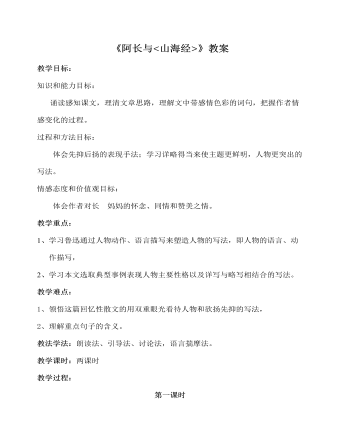
部编版语文七年级下册《阿长与山海经》教案
教学目标: 知识和能力目标:诵读感知课文,理清文章思路,理解文中带感情色彩的词句,把握作者情感变化的过程。 过程和方法目标:体会先抑后扬的表现手法;学习详略得当来使主题更鲜明,人物更突出的写法。 情感态度和价值观目标:体会作者对长 妈妈的怀念、同情和赞美之情。教学重点:1、 学习鲁迅通过人物动作、语言描写来塑造人物的写法,即人物的语言、动作描写,2、 学习本文选取典型事例表现人物主要性格以及详写与略写相结合的写法。教学难点:1、 领悟这篇回忆性散文的用双重眼光看待人物和欲扬先抑的写法,2、 理解重点句子的含义。教法学法:朗读法、引导法、讨论法,语言揣摩法。教学课时:两课时 教学过程:第一课时一、导入在鲁迅先生的散文《从百草园到三味书屋》里,鲁迅除写了自己的老师寿镜吾先生之外,还写到了一个人,这个人是谁呢?
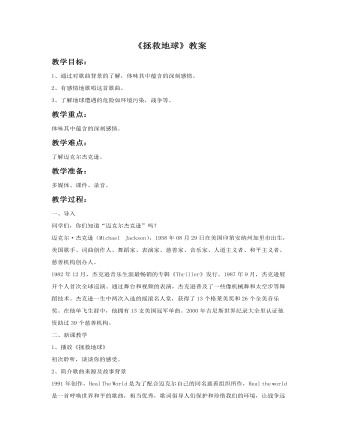
《拯救地球》教案
教学过程:一、导入同学们,你们知道“迈克尔杰克逊”吗?迈克尔·杰克逊(Michael Jackson),1958年08月29日在美国印第安纳州加里市出生,美国歌手、词曲创作人、舞蹈家、表演家、慈善家、音乐家、人道主义者、和平主义者、慈善机构创办人。1982年12月,杰克逊音乐生涯最畅销的专辑《Thriller》发行。1987年9月,杰克逊展开个人首次全球巡演。通过舞台和视频的表演,杰克逊普及了一些像机械舞和太空步等舞蹈技术。杰克逊一生中两次入选的摇滚名人堂,获得了13个格莱美奖和26个全美音乐奖。在他单飞生涯中,他拥有13支美国冠军单曲。2000年吉尼斯世界纪录大全里认证他资助过39个慈善机构。二、新课教学1、播放《拯救地球》初次聆听,谈谈你的感受。2、简介歌曲来源及故事背景1991年创作,Heal The World 是为了配合迈克尔自己的同名慈善组织所作,Heal the world是一首呼唤世界和平的歌曲,相当优秀,歌词倡导人们保护和珍惜我们的环境,让战争远离,世界和平,我们的心中都有一个地方,那就是爱,让我们营造一个没有战争、没有荒地,生机勃勃,到处充满了温暖和关怀的世界,让孩子们可以自由的欢笑,让世界充满爱。
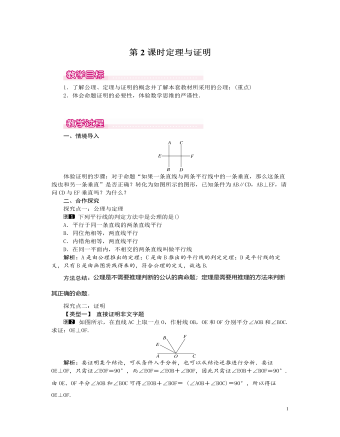
北师大初中数学八年级上册定理与证明1教案
求证:直角三角形的两个锐角互余.解析:分析这个命题的条件和结论,根据已知条件和结论画出图形,写出已知、求证,并写出证明过程.已知:如图所示,在△ABC中,∠C=90°.求证:∠A与∠B互余.证明:∵∠A+∠B+∠C=180°(三角形内角和等于180°),又∠C=90°,∴∠A+∠B=180°-∠C=90°.∴∠A与∠B互余.方法总结:解此类题首先根据题意将文字语言变成符号语言,画出图形,最后再经过分析论证,并写出证明的过程.三、板书设计命题分类公理:公认的真命题定理:经过证明的真命题证明:推理的过程经历实际情境,初步体会公理化思想和方法,了解本教材所采用的公理,让学生对真假命题有一个清楚的认识,从而进一步了解定理、公理的概念.培养学生的语言表达能力.
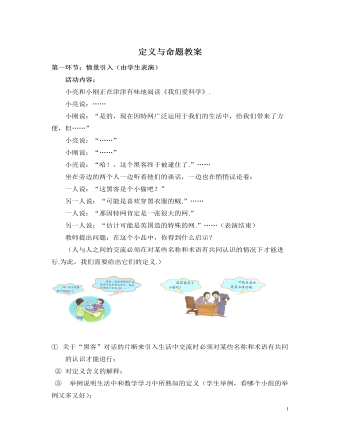
北师大初中数学八年级上册定义与命题2教案
② 命题的含义:判断一件事情的句子,叫做命题,如果一个句子没有对某一件事情作出任何判断,那么它就不是命题.活动目的:通过课后的总结,使学生对定义、命题等概念有更清楚的认识,让学生在头脑中对本节课进行系统的归纳与整理.教学效果:学生在有了前面对定义、特别是命题概念的学习后,能了解命题的结构,以及哪些是命题,使学生对命题的学习有了清楚的认识。第五环节 课后练习学习小组搜集八年级数学课本中的新学的部分定义、命题,看谁找得多.四、教学反思本节课的设计具有如下特点:(1)采用了“小品表演”的形式引入新课,意在激起学生对数学的兴趣,让学生知道,数学不是枯燥无味的。并能从表演中不同的人对“黑客”这个名词的不同理解更好地悟出“定义”的含义。
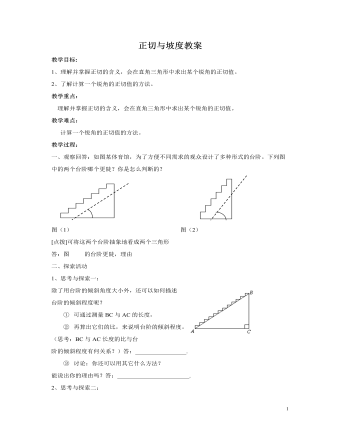
北师大初中九年级数学下册正切与坡度2教案
教学目标:1、理解并掌握正切的含义,会在直角三角形中求出某个锐角的正切值。2、了解计算一个锐角的正切值的方法。教学重点:理解并掌握正切的含义,会在直角三角形中求出某个锐角的正切值。教学难点:计算一个锐角的正切值的方法。教学过程:一、观察回答:如图某体育馆,为了方便不同需求的观众设计了多种形式的台阶。下列图中的两个台阶哪个更陡?你是怎么判断的?图(1) 图(2)[点拨]可将这两个台阶抽象地看成两个三角形答:图 的台阶更陡,理由 二、探索活动1、思考与探索一:除了用台阶的倾斜角度大小外,还可以如何描述台阶的倾斜程度呢?① 可通过测量BC与AC的长度,② 再算出它们的比,来说明台阶的倾斜程度。(思考:BC与AC长度的比与台阶的倾斜程度有何关系?)答:_________________.③ 讨论:你还可以用其它什么方法?能说出你的理由吗?答:________________________.2、思考与探索二:
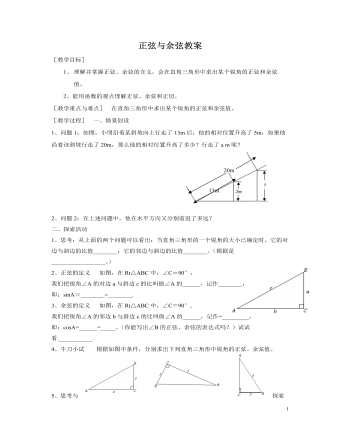
北师大初中九年级数学下册正弦与余弦2教案
[教学目标]1、 理解并掌握正弦、余弦的含义,会在直角三角形中求出某个锐角的正弦和余弦值。2、能用函数的观点理解正弦、余弦和正切。[教学重点与难点] 在直角三角形中求出某个锐角的正弦和余弦值。[教学过程] 一、情景创设1、问题1:如图,小明沿着某斜坡向上行走了13m后,他的相对位置升高了5m,如果他沿着该斜坡行走了20m,那么他的相对位置升高了多少?行走了a m呢?2、问题2:在上述问题中,他在水平方向又分别前进了多远?二、探索活动1、思考:从上面的两个问题可以看出:当直角三角形的一个锐角的大小已确定时,它的对边与斜边的比值________;它的邻边与斜边的比值________。(根据是__________________。)2、正弦的定义 如图,在Rt△ABC中,∠C=90°,我们把锐角∠A的对边a与斜边c的比叫做∠A的______,记作________,即:sinA=________=________.3、余弦的定义 如图,在Rt△ABC中,∠C=90°,我们把锐角∠A的邻边b与斜边c的比叫做∠A的______,记作=_________,即:cosA=______=_____。(你能写出∠B的正弦、余弦的表达式吗?)试试看.___________.
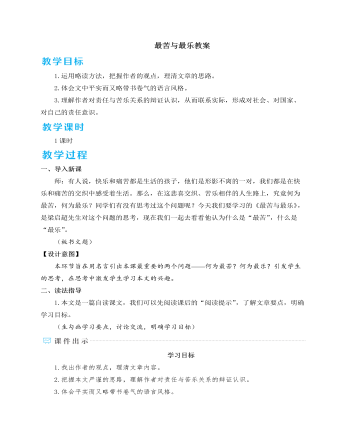
人教部编版七年级下册最苦与最乐教案
梁启超(1873—1929),字卓如,号任公,别号饮冰室主人。广东新会人,思想家、学者。清朝光绪年间举人,戊戌变法(百日维新)领袖之一、中国近代维新派、新法家代表人物。幼年受传统教育,光绪十年(1884)中秀才,1889年中举。后从师于康有为,成为资产阶级改良派的宣传家。维新变法前,协助康有为一起联合在京应试举人发动“公车上书”运动,此后先后领导北京和上海的强学会,又与黄遵宪一起办《时务报》,任长沙时务学堂的总教习,并著《变法通议》为变法做宣传。戊戌变法失败后,逃亡日本。晚年任清华国学研究院导师。他一生著述颇丰,著有《清代学术概论》《中国近三百年学术史》等,著作大多收入《饮冰室合集》。文学知识议论文议论文是一种以议论为主要表达方式,通过摆事实、讲道理,直接表达作者的观点和主张的常用文体。论点、论据和论证,是议论文的三要素。
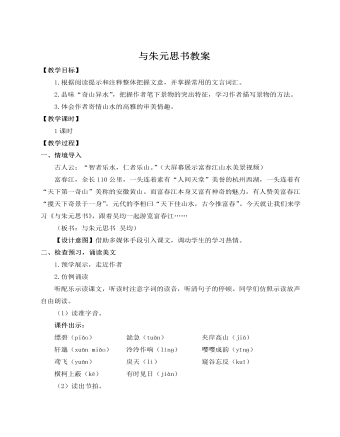
人教部编版语文八年级上册与朱元思书教案
吴均是一位善写山水的大家,他自小好学而又才智出众,但“家世寒贱”,性格耿直。在门阀制度相当严格的南朝梁,出身于庶族寒门的人,想要在政治上得到重用,着实不易,再加上他性格直来直去,口无遮拦,更是会四处碰壁。所幸的是,起先著名文史学家沈约看中了吴均的文章,“颇相称赏”。接着,吴均得到了刺史柳恽的赏识,提拔他当了郡主簿,常在一起赋诗答对。他的诗文“清拔有古气”,自成一家,时人纷纷效仿,称为“吴均体”。书信内容为何是山水游记魏晋六朝是中国历史上政治最混乱、社会最痛苦的时代,然而却是精神上极自由、极富智慧和艺术精神的时代。大自然成了情趣高雅之士审美活动的重要背景和舞台,移情山水成了当时的社会风尚。在书信中描画山水,寄托情志,成为好友间交流的一种流行方式,文人们通过书信内敛地表露自己的人生取向,他们的文学经历给后世留下了宝贵的文化遗产。吴均的《与朱元思书》《与施从事书》和《与顾章书》,以及陶弘景的《答谢中书书》皆是如此。
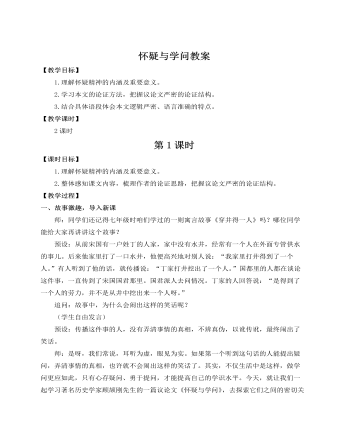
人教部编版语文九年级上册怀疑与学问教案
1.理解怀疑精神的内涵及重要意义。2.整体感知课文内容,梳理作者的论证思路,把握议论文严密的论证结构。【教学过程】一、故事激趣,导入新课师:同学们还记得七年级时咱们学过的一则寓言故事《穿井得一人》吗?哪位同学能给大家再讲讲这个故事?预设:从前宋国有一户姓丁的人家,家中没有水井,经常有一个人在外面专管供水的事儿。后来他家里打了一口水井,他便高兴地对别人说:“我家里打井得到了一个人。”有人听到了他的话,就传播说:“丁家打井挖出了一个人。”国都里的人都在谈论这件事,一直传到了宋国国君那里。国君派人去问情况。丁家的人回答说:“是得到了一个人的劳力,并不是从井中挖出来一个人呀。”追问:故事中,为什么会闹出这样的笑话呢?(学生自由发言)预设:传播这件事的人,没有弄清事情的真相,不辨真伪,以讹传讹,最终闹出了笑话。




